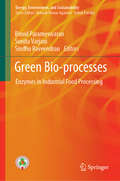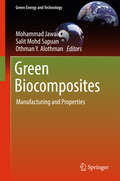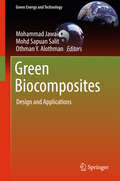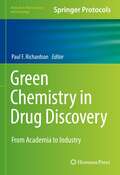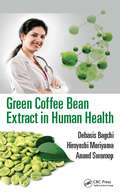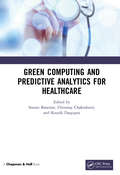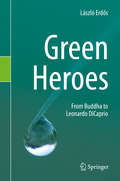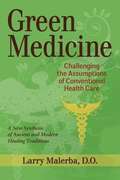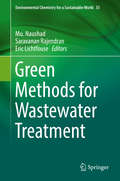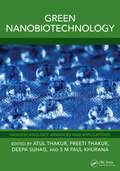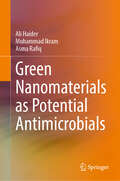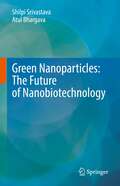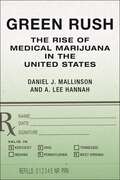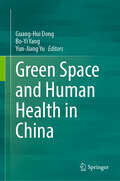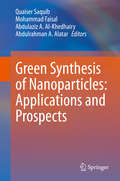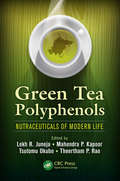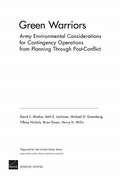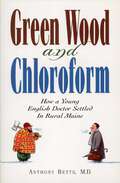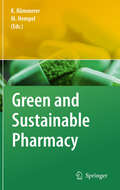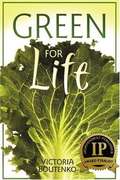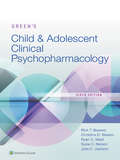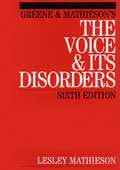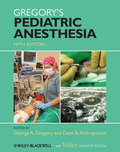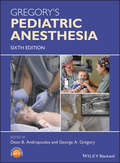- Table View
- List View
Green Bio-processes: Enzymes in Industrial Food Processing (Energy, Environment, and Sustainability)
by Binod Parameswaran Sunita Varjani Sindhu RaveendranThis volume discusses recent advancements to the age old practice of using microbial enzymes in the preparation of food. Written by leading experts in the field, it discusses novel enzymes and their applications in the industrial preparation of food to improve taste and texture, while reducing cost and increasing consistency. This book will be of interest to both researchers and students working in food technology.
Green Biocomposites
by Mohammad Jawaid Othman Y. Alothman Salit Mohd SapuanThis book addresses different aspects of green biocomposite manufacture from natural fibres and bioplastics, including the manufacturing procedures and the physical, mechanical, thermal and electrical properties of green biocomposites. Featuring illustrations and tables that maximize reader insights into the current research on biocomposites, it emphasises the role of green technology in the manufacture of biocomposites and analysis of properties of biocomposites for different applications. It is a valuable resource for researchers and scientists in industry wanting to understand the need for biocomposites in the development of green, biodegradable and sustainable products for different applications.
Green Biocomposites
by Mohd Sapuan Salit Mohammad Jawaid Othman Y. AlothmanThis book introduces the concept, design and application of green biocomposites, with a specific focus on the current demand for green biocomposites for automotive and aerospace components. It discusses the mathematical background, innovative approaches to physical modelling, analysis and design techniques. Including numerous illustrations, tables, case studies and exercises, the text summarises current research in the field. It is a valuable reference resource for researchers, students and scientists working in the field of materials science.
Green Chemistry in Drug Discovery: From Academia to Industry (Methods in Pharmacology and Toxicology)
by Paul F. RichardsonThis detailed book highlights several emerging areas in the implementation of green chemistry in medicinal chemistry drug discovery with a specific focus on their application to the expeditious discovery of new biologically active entities. Divided into three sections, the collection explores greener approaches to chemical transformations that are both prevalent and have been highlighted as challenging within the pharmaceutical industry, overall synthetic strategy, as well as the implementation and impact of a range of enabling technologies within medicinal chemistry. As a volume of the Methods in Pharmacology and Toxicology series, chapters provide the kind of key insight that can guide researchers toward greater success in the lab. Authoritative and practical, Green Chemistry in Drug Discovery: From Academia to Industry provides both a fundamental insight into the progress that has been made as well as some of the challenges that still exist for these techniques to be effectively implemented in the drug discovery process in a routine manner.
Green Coffee Bean Extract in Human Health
by Debasis Bagchi Hiroyoshi Moriyama Anand SwaroopThe role of green coffee bean (GCB) in human health is of emerging interest to the nutraceutical field, especially given its role in improving metabolic syndrome, including weight management, hypertension, diabetes, and neuroprotection. GCB extract contains a novel antioxidant known as chlorogenic acid (also caffeoylquinic acid), which has been shown to positively affect blood pressure, brain health, diabetes, and weight management. This book provides information on the diverse health benefits of green coffee bean extract, molecular mechanisms and signaling pathways, safety of GCB, dosage, and recommended usage. It focuses on the chemistry, biochemistry, pharmacology, and safety of GCB extract. GCB extract has brought a remarkable revolution in the nutraceutical marketplace. However, some controversies have been demonstrated recently. This book presents the state-of-the-art research studies from eminent scientists around the world on the potential and diversified health benefits of GCB extracts, with particular emphasis placed on the importance to standardize the appropriate extraction technology, quality control and assurance, and broad spectrum safety studies and human clinical studies to substantiate the regulatory claims and position the product in the marketplace.
Green Computing and Predictive Analytics for Healthcare
by Sourav Banerjee, Chinmay Chakraborty and Kousik DasguptaGreen Computing and Predictive Analytics for Healthcare excavates the rudimentary concepts of Green Computing, Big Data and the Internet of Things along with the latest research development in the domain of healthcare. It also covers various applications and case studies in the field of computer science with state-of-the-art tools and technologies. The rapid growth of the population is a challenging issue in maintaining and monitoring various experiences of quality of service in healthcare. The coherent usage of these limited resources in connection with optimum energy consumption has been becoming more important. The major healthcare nodes are gradually becoming Internet of Things-enabled, and sensors, work data and the involvement of networking are creating smart campuses and smart houses. The book includes chapters on the Internet of Things and Big Data technologies. Features: Biomedical data monitoring under the Internet of Things Environment data sensing and analyzing Big data analytics and clustering Machine learning techniques for sudden cardiac death prediction Robust brain tissue segmentation Energy-efficient and green Internet of Things for healthcare applications Blockchain technology for the healthcare Internet of Things Advanced healthcare for domestic medical tourism system Edge computing for data analytics This book on Green Computing and Predictive Analytics for Healthcare aims to promote and facilitate the exchange of research knowledge and findings across different disciplines on the design and investigation of healthcare data analytics. It can also be used as a textbook for a master’s course in biomedical engineering. This book will also present new methods for medical data evaluation and the diagnosis of different diseases to improve quality-of-life in general and for better integration of Internet of Things into society. Dr. Sourav Banerjee is an Assistant Professor at the Department of Computer Science and Engineering of Kalyani Government Engineering College, Kalyani, West Bengal, India. His research interests include Big Data, Cloud Computing, Distributed Computing and Mobile Communications. Dr. Chinmay Chakraborty is an Assistant Professor at the Department of Electronics and Communication Engineering, Birla Institute of Technology, Mesra, India. His main research interests include the Internet of Medical Things, WBAN, Wireless Networks, Telemedicine, m-Health/e-Health and Medical Imaging. Dr. Kousik Dasgupta is an Assistant Professor at the Department of Computer Science and Engineering, Kalyani Government Engineering College, India. His research interests include Computer Vision, AI/ML, Cloud Computing, Big Data and Security.
Green Heroes: From Buddha to Leonardo DiCaprio
by László ErdősThis book provides an introduction into the diversity of the environmental movement through great characters in the green sector. The book describes inspiring personal achievements, and at the same time it provides readers with information regarding the history, the main directions and the ethical principles of the environmental movement. Some of the most important characters of the movement from all around the world, are included in the book. As well as the title characters, Buddha and Leonardo DiCaprio, other famous environmentalists like Albert Schweitzer, David Attenborough and Jane Goodall are discussed. Some of the less well-known but equally important environmentalists such as Chico Mendes, Bruno Manser, Henry Spira, Tom Regan or Rossano Ercolini are highlighted in the various chapters. The selection of characters represents all major branches within the green sector, ranging from medieval saints to Hollywood celebrities, from university professors to field activists, from politicians to philosophers, from ecofeminists to radicals.
Green Medicine
by Larry MalerbaAccording to Dr. Larry Malerba, modern medicine has perfected the short-term technical repair of the physical body at the expense of the long-term psychological and spiritual well-being of the whole person. In Green Medicine he examines this issue and provides a realistic blueprint for wellness and a valuable guide for those seeking deeper and more lasting healing. Written in an accessible style, the book draws on a rich range of fields--physics, philosophy, Jungian thought, shamanism, alchemy, Eastern thought, Western esotericism, sustainability, orthodox medicine--to create a green medical paradigm that represents a powerful integrative medical perspective.Dr. Malerba interweaves case histories from his own practice with innovative concepts from alternative and Western medicine in order to address a number of crucial questions: * What are the personal and environmental costs to the overuse of pharmaceutical drugs?* Is conventional medicine as scientific as it claims to be?* How can conventional doctors and alternative healers begin to work together? * How can individuals transform medicine and become participants in their own healthcare? Green Medicine offers a practical and philosophical basis for building a viable green alternative that draws on the inherent unity of body, heart, mind, soul, and nature.From the Trade Paperback edition.
Green Methods for Wastewater Treatment (Environmental Chemistry for a Sustainable World #35)
by Eric Lichtfouse Mu. Naushad Saravanan RajendranThis book presents comprehensive chapters on the latest research and applications in wastewater treatment using green technologies. Topics include mesoporous materials, TiO2 nanocomposites and magnetic nanoparticles, the role of catalysts, treatment methods such as photo-Fenton, photocatalysis, electrochemistry and adsorption, and anti-bacterial solutions. This book will be useful for chemical engineers, environmental scientists, analytical chemists, materials scientists and researchers.
Green Nanobiotechnology (Nanotechnology Advances and Applications)
by Atul Thakur Preeti Thakur Deepa Suhag Khurana, S. M. PaulThis book provides a comprehensive exploration of green nanotechnology covering principles, applications, and ethical considerations.Green Nanobiotechnology begins with an introductory exploration of nanotechnology, followed by in-depth discussions on the synthesis of ozone-friendly nanomaterials and the emerging practice of green synthesis. It delves into the diverse applications of green nanoparticles, spanning biomedical applications, tissue engineering, biosensors, antimicrobials, and vaccine development. It explores applications of nanotechnology in environmental sciences including bioremediation, microengineered ceramics for environmental protection, and the modification of advanced nano-polymer composites. The environmental fate and ecotoxicological implications of nanomaterials are thoroughly examined, followed by discussions on the energy-saving potential and sustainable fuel development in the realm of green nanotechnology. The book concludes with a focus on responsible and ethical considerations, addressing the legal, socio-economic, and ethical impacts of nanotechnology, making it an important resource for researchers, academics, and professionals in nanobiotechnology and biomedical sciences.
Green Nanomaterials as Potential Antimicrobials
by Muhammad Ikram Ali Haider Asma RafiqThis book focuses on nanomaterials with antibacterial properties. Antibacterial resistance is a growing concern that poses a serious threat to public health worldwide. This book looks at the fabrication, material's properties, and characterization of a range of metallic, bimetallic, and metal-oxide-based nanomaterials that can be exploited for their antimicrobial properties. A key focus of this book is its emphasis on ‘green’ synthesis of nanomaterials, as many conventional routes of nanomaterial fabrication do not fulfill key sustainability criteria in terms of their toxicity and lack of eco-friendliness. Additionally, this book introduces the application of nanoparticles to veterinary medicine. Given the ever-increasing global livestock population coupled with the emergence of drug-resistant pathogens of animal origin (bacterial, parasitic, and hemoprotozoa), the use of nanoparticles as antibacterial agents represents a paradigm shift in every aspect of veterinary care. Authored by scholars with combined expertise in nanomaterials and veterinary medicine, this book provides valuable information for researchers working on sustainable nanomaterials with antibacterial properties.
Green Nanoparticles: The Future of Nanobiotechnology
by Shilpi Srivastava Atul BhargavaThis book discusses the fundamental concepts of the green synthesis of nanoparticles and presents the latest advances in this emerging field. Providing a comprehensive overview of developments related to nanoparticle synthesis using fungi, algae, bryophytes, pteridophytes, gymnosperms, monocotyledons, dicotyledonous (angiosperms) and animal systems, it also explores techniques for the characterization of these nanoparticles. Lastly, it reviews the applications and toxicity of biologically synthesized green nanoparticles. Given its scope, it is a valuable resource for students, researchers and policymakers working in the field of nanobiotechnology and nanoscience.
Green Parrots: A War Surgeon's Diary
by Howard Zinn Gino StradaDesigned to look like toys, green parrots are small, winged cylinders roughly four inches long that flutter over lands devastated by war, but are, in fact, antipersonnel mines. This book introduces us to the endless destruction that the green parrots have spread throughout the world, and in so doing raises an urgent question: Is it legitimate to accept war as an inevitable prospect for current and future generations? After appearing in numerous languages since its initial publication in 1999, this English edition is particularly timely. The appendix of "Green Parrots" contains the complete text of the Universal Declaration of Human Rights, approved on December 10, 1948 by the General Assembly of the United Nations, which begins by proclaiming: "All human beings are born free and equal in dignity and rights. "
Green Rush: The Rise of Medical Marijuana in the United States
by Daniel J. Mallinson A. Lee HannahA state-by-state analysis of the expansion of medical marijuana access in the United StatesAs of 2023, thirty-eight states and the District of Columbia have legalized the medical use of marijuana. Twenty-three have legalized recreational use, supporting what is now a flourishing multibillion-dollar industry. In Green Rush, Daniel J. Mallinson and A. Lee Hannah offer a fascinating history of cannabis legalization in America, highlighting the people, states, and policies that made these victories possible.With sharp insight, Mallinson and Hannah explore the backdrop to this sea change in policy, including shifts in public opinion, growing opposition to the War on Drugs, the promise of new revenue streams, and more. They examine the complex web of state actors—and the steps they took—to chart a path forward for marijuana legalization, from grassroots activists and interest groups to elected officials and other key policymakers.Mallinson and Hannah show us how states like Pennsylvania, Ohio, and West Virginia not only created, legitimized, and spread medical marijuana policy but also learned from each other’s successes and failures throughout the process. As marijuana legalization increasingly finds its way onto state ballots, Green Rush offers fresh insight into how we got here as a country and where we are going—one state at a time.
Green Space and Human Health in China
by Guang-Hui Dong Bo-Yi Yang Yun-Jiang YuThis book focuses on summarizing the effects of greenspace exposures on human health in China. It also discusses the new methodologies assessing greenspace exposure and new methods exploring potential mechanisms underlying them. In particular, it takes into account trends in the types of studies and measurement of variables over time, as well as sources of geographical heterogeneity given uneven development across the China’s vast terrain. This book aims at providing researchers, health professionals, and policy makers a cutting-edge and comprehensive summary of researches on greenness and human health.
Green Synthesis of Nanoparticles: Applications and Prospects
by Quaiser Saquib Mohammad Faisal Abdulaziz A. Al-Khedhairy Abdulrahman A. AlatarThis book describes various strategies for the synthesis of green nanoparticles using plant extracts and microbes, including the advantages and disadvantages of different methods and their applications.After discussing strategies for and the potential of green synthesis of noble metal nanoparticles, it highlights the role of the solvent system. The book then explores the stability/toxicity of nanoparticles and the associated-surface engineering techniques for achieving biocompatibility, and examines the antimicrobial efficacy of green nanoparticles with regard to various bacterial pathogens, as well as the underlying cytotoxicity mechanisms.Lastly, the book addresses the potential applications of various green nanoparticles in cancer theranostics, and reviews a number of plant-mediated nanoparticles as potential pharmaceutical agents. Given its scope, the book will be of interest to all scientists and students wanting to learn more about the synthesis and applications of green nanoparticles.
Green Tea Polyphenols: Nutraceuticals of Modern Life
by Lekh R. Juneja Mahendra P. Kapoor Tsutomu Okubo Theertham P. RaoThere is a wealth of published research on the health-promoting effects of green tea and its various components including polyphenols. Green Tea Polyphenols: Nutraceuticals of Modern Life presents a collection of global findings on the numerous health benefits of green tea polyphenols, confirming their position as healthy functional ingredients. Wi
Green Warriors
by Michael D. Greenberg David E. Mosher Brian Rosen Tiffany Nichols Beth E. LachmanThis study assesses whether Army policy, doctrine, and guidance adequately address environmental activities in post-conflict phases of contingencies. A review of policy, doctrine, operational experience, and documentation, as well as interviews with Army personnel, indicates that environmental concerns can have significant impacts. Recommendations are made for improving the Army?s approach to environmental issues in contingency operations.
Green Wood and Chloroform: How a Young English Doctor Settled in Rural Maine
by Anthony BettsLike many new general practitioners in the 1950s, Dr. Anthoy Betts faced few real opportunities under the new British National Health Care system. So, with little more than a suitcase, he and his wife and two babies set off for the U.S.A.Moving to rural Maine in the middle of January, they quickly learned practical lessons about snow tires, long johns, dry gas, and the distinction between "green" and "white" firewood. Dr. Betts also found that his new practice sometimes required procedures not endorsed in any modern medical text—for example, home births took place atop a thick layer of newspapers spread on the floor in front of the wood stove! He was expected to be on call at all times, though he learned that if he hung a "Gone Fishing" sign on his door nobody would question his absence. And he also quickly learned not to trust verbal directions to houses on back-country roads.Despite the differences of language and social custom, the young urban Englishman was welcomed by most of his patients and fellow doctors—even sharing an office with Dr. Jack Hornberger, the real Hawkeye and author of M*A*S*H, newly returned from Korea to build his own practice.Dr. Betts's sense of humor helped him adapt to the strange culture he encountered in Maine. And it is that same wry amusement that makes this memoir so immensely enjoyable.
Green and Sustainable Pharmacy
by Maximilian Hempel Klaus KümmererWithin recent years pharmaceuticals have come into focus as contaminants of the environment (see for example Kümmerer, K. editor: Pharmaceuticals in the Environment). At the same time the issue of sustainable chemistry gained momentum. Bringing both together would result in sustainable pharmacy. Sustainable pharmacy is a totally new issue and approach. It addresses environmental, economical and social aspects of pharmacy. In the present stage the focus will be on environmental issues along the whole lifecycle of a pharmaceutical entity. That is dealing with resources and energy input but also with waste issues for example during the synthesis and production of an active pharmaceutical ingredient. Furthermore, it would also look on the compounds themselves and will aim to improve the degradability of the compounds after their use in the environment to reduce the environmental risk caused by pharmaceuticals in the environment. Another issue is the people using pharmaceuticals such as pharmacists, medical doctors and patients. How can they contribute to more efficient use of pharmaceuticals with less environmental burden and less risk for drinking water. The book "Sustainable Pharmacy" will address all these issues and will be the first one dealing with this important topic.
Green for Life
by Victoria BoutenkoPeople know that we should eat more greens, but rarely do any of us truly enjoy our kale or wheatgrass. For the first time in history an enjoyable way of consuming the necessary amount of greens has been created by blending the greens with fruit.
Green's Child and Adolescent Clinical Psychopharmacology
by Rick Bowers Julia Jackson Christina WestonPublisher's Note: Products purchased from 3rd Party sellers are not guaranteed by the Publisher for quality, authenticity, or access to any online entitlements included with the product. The sixth edition of this classic text continues to provide clinically-oriented information on medications used to treat common mental health conditions and disorders in children and adolescents. The book boasts an accessible style—with even more tables, graphs, and clinical pearls than ever before—that is designed for easy reading and comprehension. Substantially updated with expanded medication coverage for new FDA approved indications, this practical guide is perfect for residents and practitioners in psychiatry and pediatrics, as well as family medicine.
Greene and Mathieson's The Voice and its Disorders (Sixth Edition)
by Lesley MathiesonThis edition has been extensively rewritten in order to reflect the changes in clinical practice and learning methods which have taken place since the 5th edition was published. The seventeen chapters are divided into three sections: normal voice, descriptions of the various types of voice disorders, and the methods of treating abnormal voice. A profile summary of each voice disorder is provided for easy reference and comparison, and tables are used throughout the text. New laryngeal images and electroglottographic interpretations have also been included. The current emphasis on evidence-based practice is addressed in the review and descriptions of intervention strategies used in voice therapy.
Gregory's Pediatric Anesthesia
by George A. Gregory Dean B. AndropoulosMillions of pediatric patients receive anesthetics every year, but it has been established that those under 12 months of age have a higher risk of poor outcomes. Well established at the forefront of the field, and founded and edited by one of its modern pioneers, Pediatric Anesthesia is renowned for the excellence of its practical guidance. Aimed at pediatric anesthetists, anesthetists, and trainee anesthetists, this new edition covers the use of anesthesia on newborns to young adults, placing a strong emphasis on the most recent and important information from research and publications.
Gregory's Pediatric Anesthesia
by George A. Gregory Dean B. AndropoulosAs the field pediatric anesthesia advances and expands, so too does the gamut of challenges that are faced by today’s anesthesiologists. Gregory’s Pediatric Anesthesia aims to fully prepare trainees and experienced professionals for modern practice by equipping them with the knowledge and cutting-edge techniques necessary to safely and successfully anesthetize children for a range of different surgeries and other procedures. Supporting their work with current data and evidence, the authors explore topics including basic principles, potential complications, and best practice, and illustrate their findings with detailed case studies that cover all major subspecialties. This essential new edition includes access to illustrative videos and features new and expanded sections, such as: Anesthesia for Spinal Surgery complications including postoperative blindness Robotic surgery for Pediatric Urological Procedures Anesthesia for Non-Cardiac Surgery in Patients with Congenital Heart Disease (new chapter) Extensive additional ultrasound images for regional anesthesia Neonatal Resuscitation The Pediatric Surgical Home and Enhanced Recovery after Surgery (new chapter) Now in its sixth edition, Gregory’s Pediatric Anesthesia continues to provide reliable and easy-to-follow guidance to all anesthesiologists caring for younger patients.
